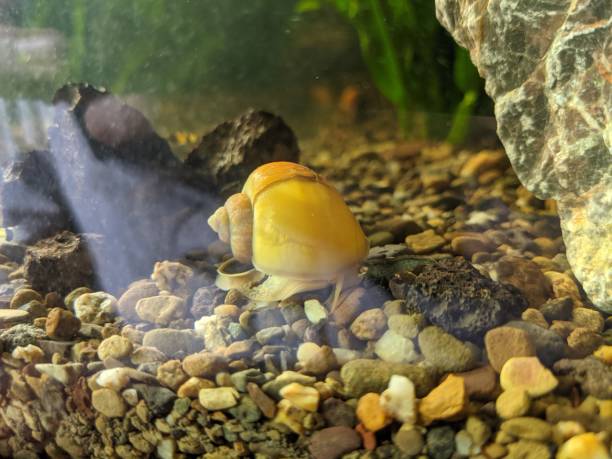The Fascinating World of Aquatic Snails: Nature's Tiny Underwater Gardeners
Dive into the captivating realm of aquatic snails, the unsung heroes of freshwater ecosystems. These miniature marvels play a crucial role in maintaining the delicate balance of underwater habitats, all while exhibiting remarkable adaptations and behaviors that have intrigued scientists and aquarium enthusiasts alike.

The Evolution of Aquatic Snails
Aquatic snails have a long and intriguing evolutionary history that spans millions of years. These gastropods first emerged in marine environments during the Cambrian period, approximately 541 million years ago. Over time, some species adapted to freshwater habitats, developing unique features to cope with the challenges of life in rivers, lakes, and ponds.
The transition from marine to freshwater environments required significant adaptations. Aquatic snails evolved specialized respiratory systems, allowing them to extract oxygen from water more efficiently. Some species developed a lung-like organ called a pulmonary sac, enabling them to breathe air when necessary. This adaptation proved crucial for survival in shallow or oxygen-depleted waters.
Another key evolutionary development was the modification of their shells. Freshwater snails typically have thinner, lighter shells compared to their marine counterparts, making it easier for them to move in less buoyant environments. Some species even developed the ability to seal their shell opening with a structure called an operculum, protecting them from predators and allowing them to survive temporary dry periods.
Ecological Importance of Aquatic Snails
Aquatic snails play a vital role in maintaining the health and balance of freshwater ecosystems. As nature’s tiny underwater gardeners, they perform several crucial functions that benefit the entire aquatic community.
One of their primary roles is algae control. Many species of aquatic snails are voracious algae eaters, helping to prevent excessive algal growth that can lead to harmful algal blooms. By grazing on algae, they help maintain water clarity and ensure that other aquatic plants receive sufficient sunlight for photosynthesis.
Snails also contribute to nutrient cycling in aquatic environments. As they feed and excrete, they break down organic matter and release nutrients back into the water. This process helps distribute essential nutrients throughout the ecosystem, supporting the growth of aquatic plants and microorganisms.
Furthermore, aquatic snails serve as important food sources for many fish, birds, and other aquatic predators. Their presence in an ecosystem indicates a healthy food web and biodiversity. Some species of snails also act as bioindicators, their populations reflecting changes in water quality and environmental conditions.
Diverse Adaptations and Behaviors
The world of aquatic snails is rich with diverse adaptations and fascinating behaviors. These creatures have evolved a wide array of strategies to thrive in various aquatic habitats, each with its own unique challenges.
Some species, like the mystery snail, have developed the ability to breathe both underwater and on land. They possess a siphon, a tube-like structure that acts like a snorkel, allowing them to draw air from the water’s surface while remaining submerged. This adaptation enables them to survive in environments with fluctuating water levels or low oxygen content.
Certain aquatic snails have evolved unique reproductive strategies. The great ramshorn snail, for instance, is a hermaphrodite, possessing both male and female reproductive organs. This adaptation increases their chances of successful reproduction, especially in isolated or low-population environments.
Many species exhibit intriguing behaviors related to predator avoidance. Some can quickly retract into their shells at the slightest disturbance, while others have developed the ability to detach from surfaces and float away when threatened. The bladder snail can even trap air bubbles in its shell, using them for buoyancy to escape predators or move to new feeding grounds.
Aquatic Snails in the Aquarium Hobby
The popularity of aquatic snails in the aquarium hobby has grown significantly in recent years. Hobbyists have come to appreciate these creatures not only for their algae-eating abilities but also for their unique appearances and behaviors.
Nerite snails, known for their striking shell patterns and excellent algae-cleaning capabilities, have become particularly popular among aquarium enthusiasts. These snails are prized for their ability to consume various types of algae without damaging live plants. In the aquarium trade, nerite snails typically range in price from $2 to $5 per snail, depending on the specific variety and size.
Another favorite among aquarists is the Malaysian trumpet snail. These burrowing snails help aerate the substrate and consume detritus, contributing to overall tank health. Their ability to reproduce rapidly has made them a common choice for establishing cleanup crews in new aquariums. Malaysian trumpet snails are often sold in groups, with prices ranging from $5 to $15 for a pack of 10-20 snails.
The impact of aquatic snails on the aquarium industry has been significant. Many pet stores and online retailers now offer a wide variety of snail species, catering to the growing demand from hobbyists. This trend has also led to increased research and breeding efforts to develop new color morphs and maintain healthy captive populations.
Conservation Challenges and Future Prospects
Despite their ecological importance, many species of aquatic snails face significant conservation challenges. Habitat destruction, pollution, and the introduction of invasive species have put numerous native snail populations at risk.
Water pollution, particularly from agricultural runoff and industrial waste, poses a severe threat to aquatic snails. Many species are highly sensitive to changes in water chemistry and can serve as early indicators of declining water quality. Efforts to improve water quality and reduce pollution are crucial for the conservation of these important creatures.
Climate change also presents a significant challenge for aquatic snails. Rising water temperatures and altered precipitation patterns can affect their habitats and life cycles. Some species may struggle to adapt to these rapid environmental changes, potentially leading to population declines or local extinctions.
On a positive note, increased awareness of the ecological importance of aquatic snails has led to more focused conservation efforts. Research into captive breeding programs for endangered species and habitat restoration projects offer hope for the future of these tiny but crucial members of aquatic ecosystems.
As we continue to unravel the mysteries of aquatic snails, it becomes clear that these small creatures play an outsized role in the health of our freshwater environments. From their evolutionary journey to their diverse adaptations and ecological contributions, aquatic snails remind us of the intricate connections that sustain life beneath the water’s surface. By appreciating and protecting these fascinating mollusks, we take an important step towards preserving the delicate balance of our planet’s aquatic ecosystems for generations to come.





